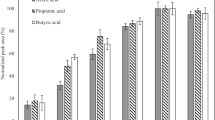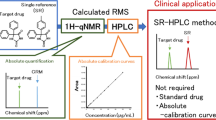Abstract
Recently, extracts from the pericarp of mangosteen, Garcinia mangostana L., exhibited various pharmacological properties such as anti-oxidative, anti-inflammatory, anti-bacterial and chemopreventive activities. Albeit it has diverse application, there is little information about its pharmacokinetic aspects. Thus, the present study was undertaken to develop the simultaneous determination of α- and γ-mangostins (α- and γ-MG), major and active compounds, from extracts for the application of pharmacokinetic studies in mice using combined liquid chromatography–tandem mass-spectrometry and microsampling systems. The intra- and inter-validation, precision, accuracy, stability, recovery and matrix effects of α- and γ-MG were conducted in mouse plasma. Based on the developed analytical methods, pharmacokinetic parameters of α- and γ-MG after intravenous and oral administration of mangosteen extract were calculated. In sample preparation steps, the biological samples were deproteinized by acetonitrile and chromatographic separation was accomplished on a C18 column. The detection was accomplished by multiple-reaction monitoring scanning after electrospray ionization source in the positive ionization mode. The optimized mass transition ion pairs (m/z) for quantitation were 411.062 → 354.900, 397.384 → 340.900, and 808.379 → 527.200 for α- and γ-MG and docetaxel (internal standard), respectively. The total run time was 5 min. The results provided a meaningful basis for the preclinical and clinical application of mangosteen extract.



Similar content being viewed by others
References
Singh SS (2006) Preclinical pharmacokinetics: an approach towards safer and efficacious drugs. Curr Drug Dispos 7:165–182
Hussain K, Ismail Z, Sadikun A, Ibrahim P (2011) Bioactive markers based pharmacokientic evaluation of extracts of a traditional medicinal plant, Piper sarmentosum. Evid Based Complement Alternet Med 20:1–7
Nahrstedt A, Butterweck V (2010) Lessons learned from herbal medicinal products: the example of St. John’s Wort. J Nat Prod 73:1015–1021
Esimone CO, Nwafor SV, Okoli CO (2002) In vivo evaluation of interaction between aqueous seed extract of Garcinia kola Heckel and ciprofloxacin hydrochloride. Am J Ther 9:275–280
Gunaratna PC, Kissinger PT, Kissinger CB, Gitzen JF (2004) An automated blood sampler for simultaneous sampling of systemic blood and brain microdialysates for drug absorption, distribution, metabolism, and elimination studies. J Pharmacol Toxicol Methods 49:57–64
Mills S, Bone K (2000) Principles and practice of phytotherapy. Churchill Livingstone, Edinburgh
Jung HA, Su BN, Keller WJ, Mehta RG, Kinghorn AD (2006) Antioxidant constitutes from the pericarp of Garcinia mangostana (Mangosteen). J Agric Food Chem 54:2077–2082
Han AR, Kim JA, Lantvit DD, Kordona LB (2009) Cytotoxic xanthone constituents of the stem bark of Garcinia mangostana (mangosteen). J Nat Prod 72:2028–2031
Chairungsrilerd N, Furukawa K, Ohta T, Nozoe S, Ohizumi Y (1996) Histaminergic and serotonergic receptor blocking substances from the medical plant Garcinia mangostatna. Planta Med 62:471–472
Jang H-Y, Kwon O-K, Oh S-R, Lee H-K, Ahn K-S (2012) Mangosteen xanthones mitigate ovalbumin-induced airway inflammation in a mouse model of asthma. Food Chem Toxicol 50:4042–4050
Chomnawang MT, Surassmo S, Wongsariya K, Bunyapraphatsara N (2009) Antibacterial activity of Thai medicinal plants against methicillin-resistant Staphylococcus aures. Fitoterapia 80:102–104
Balunas MJ, Su B, Bruegggemeier RW, Kinghorn AD (2008) Xanthones from the botanical dietary supplement mangosteen (Garcinia mangostana) with aromatase inhibitory activity. J Nat Prod 71:1161–1166
Cui J, Hu W, Cai Z, Liu Y, Li S, Tao W, Xiang H (2010) New medical properties of mangostins: analgestic activity and pharmacological characterization of active ingredients from the fruit hull of Garcinia mangostana. Pharmacol Biochem Behav 95:166–172
Chae H-S, Oh S-R, Lee H-K, Joo SH, Chin Y-W (2012) Mangosteen xanthones, α- and γ-mangostins, inhibit allergic mediators in bone marrow-derived mast cell. Food Chem 134:397–400
Quan G-H, Oh S-R, Kim J-H, Lee H-K, Kinghorn AD, Chin Y-W (2010) Xanthone constituents of the fruits of Garcinia mangostana with anticomplement activity. Phytother Res 24:1575–1577
Li L, Brunner I, Hand A-R, Hamburger M, Kinghorn AD, Frye R, Butterweck V (2011) Pharmacokinetics of α-mangostin in rats after intravenous and oral application. Mol Nutr Food Res 55:S67–S74
Us FDA (2001) Guidance for industry/bioanalytical method validation. US Food and Drug Administration, Rockville
Matuszewski BK, Constanzer ML, Chavez-Eng CM (2003) Strategies for the assessment of matrix effect in quantitative bioanalytical methods based on HPLC-MS/MS. Anal Chem 75:3019–3030
Heta T, Kita T, Kawabata A, Itoh E, Nishimura Y (1986) Changes of tissue blood flow in mice loaded with SART (repeated cold) stress or restraint and water immersion stress and the effect of the administered neurotropin. Jpn J Pharmacol 41:69–79
He H, Kramp R, Ramos L, Bakhtiar R (2001) A preliminary study on the feasibility of an automated blood-sampling system in conjunction with liquid chromatography/mass spectrometry. Rapid Commun Mass Spectrom 15:1768–1772
Hashimoto Y, Suemaru K, Yamamoto T, Kawakami K, Araki H, Gomita Y (2001) Effect of immobilization stress on anticonvulsant actions and pharmacokinetics of zonisamide in mice. Pharmacol Biochem Behav 68:7–12
Wang SC, Ho LK, Yen JC, Tsai TH (2006) An automated blood sampling system to measure lovastatin level in plasma and feces. Biomed Chromatogr 20:911–916
Zhu Y, Kissinger CB, Bromet N, Kissinger PT (2006) How a rodent is dosed and sampled is equally important to how samples are analyzed: automated dosing, sampling and LC–MS/MS with ion traps and triple quads. Asian J Pharmacodyn Pharmacokinet 6:121–132
Acknowledgments
This study was supported by the grant of National Research Foundation of Korea (NRF) funded by the government of Korea (S-2012-004424; Y.H. Choi).
Conflict of interest
None declared.
Author information
Authors and Affiliations
Corresponding author
Rights and permissions
About this article
Cite this article
Han, S.Y., Chin, YW., Kim, D.Y. et al. Simultaneous Determination of α- and γ-Mangostins in Mouse Plasma by HPLC–MS/MS Method: Application to a Pharmacokinetic Study of Mangosteen Extract in Mouse. Chromatographia 76, 643–650 (2013). https://doi.org/10.1007/s10337-013-2437-3
Received:
Revised:
Accepted:
Published:
Issue Date:
DOI: https://doi.org/10.1007/s10337-013-2437-3




